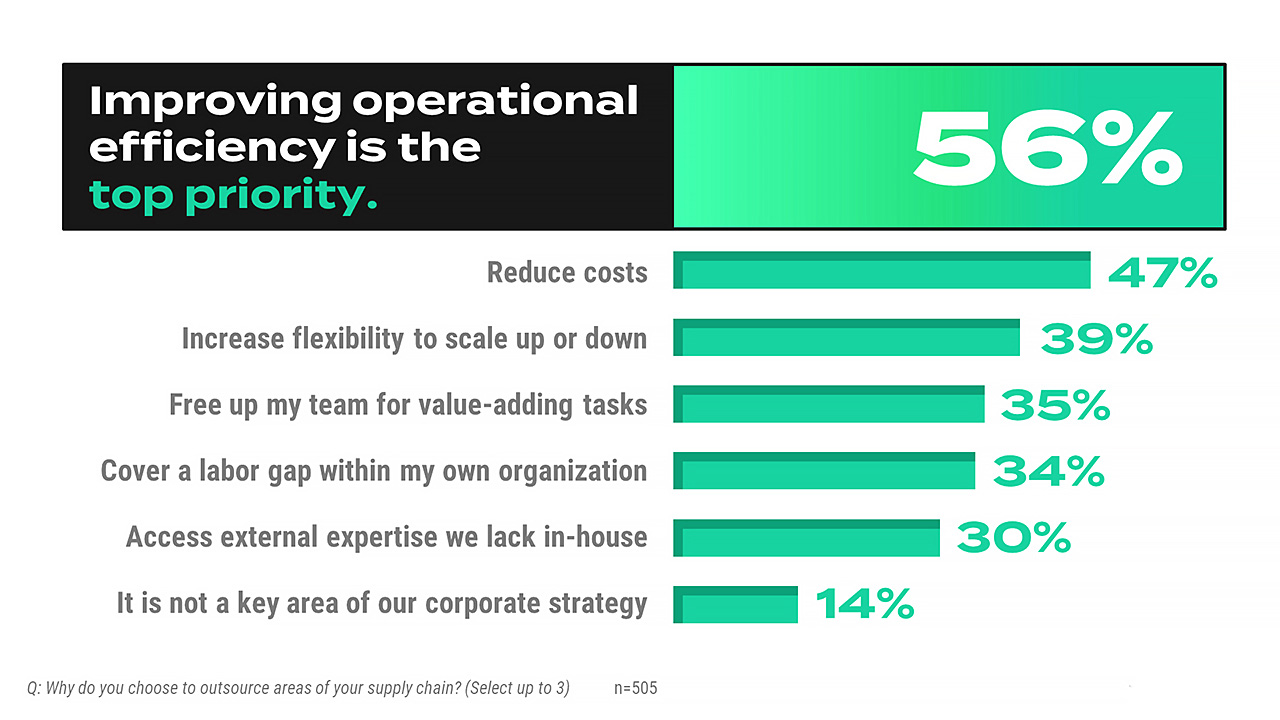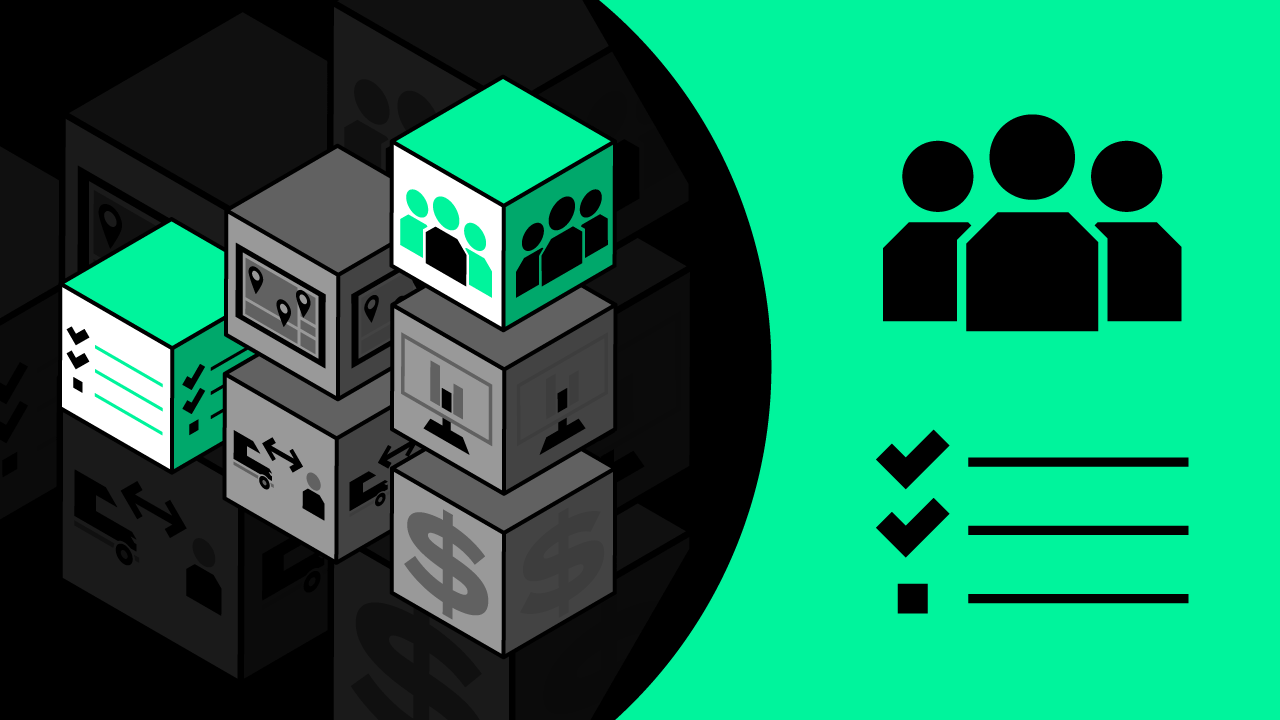Do you feel like you’re paying high shipping costs and getting subpar service?
Is supply chain planning difficult for you? What about day-to-day vendor management?
It might be time to consider outsourcing your supply chain operations.
But it’s no easy choice.
The debate between building your own in-house logistics capabilities and buying support from a third-party provider is a tricky one.
Learn what shipping functions your peers are outsourcing and how to tell if it’s right for you.
Considering Outsourcing Your Supply Chain Operations? Get Answers to the Questions That Matter:
When Is It Time to Think About Buying Instead of Building?
If you’re thinking about outsourcing, you’re in good company.
In our original research study on supply chain outsourcing, looking across 21 areas of supply chain management, 76% of shippers, on average, think at least some level of outsourcing is the ideal approach.
There are no two ways around it — you’re going to need to spend some money to reap the benefits of an outsourced supply chain, but over the long-haul, nearly half of shippers actually find cost reductions, regardless of size.

Get more insights like this in the full supply chain outsourcing research study.
In general, it’s time to think about buying vs. building if:
- Buying will significantly reduce HR headaches.
Determine if the time and resources spent on benefits, onboarding and payroll outweigh the cost of outsourcing. - Your business is very seasonal.
When your needs are much more complex during surge periods, you might not want to keep on full-time staff to handle them. - Non-logistics personnel are tendering or tracking freight.
You don’t want someone on your accounting team to waste their time with tasks outside their expertise. - You’re often behind in your payments to carriers.
If accounting paperwork is building up faster than your team can handle it, you could jeopardize some of your most important carrier relationships. - You aren’t getting the most out of your KPIs (or using them at all).
Your logistics data should be used to improve performance; if it isn’t, you might need to outsource your KPI management. - Carrier performance is diminishing.
Scorecarding is a necessary but time-consuming part of a carrier relationship; if your team can’t keep up, you can outsource to one that can. - You struggle to interpret and act on data housed in multiple systems.
It might be time to bring in experts to centralize your transportation data.
What Supply Chain Functions Can I Outsource?
Any part of your supply chain from end to end can be outsourced to a team of experts.
This includes both high-level consulting and boots-on-the-ground execution.
You can get a full breakdown of how over 500 shippers outsource across 21 areas of supply chain management in our original research study, but we’ll break down some of the most popular logistics functions here:
RFP Management
What is it? Let your provider run your bid for you and advise on awards (or make award decisions themselves).
When to build: When your incumbent carrier mix is providing strong service at reasonable rates and you are simply trying to renew for another annual cycle.
When to buy: In very volatile rate environments, if you’re not satisfied with the quantity of carriers you have in your bid mix or when your incumbent network isn’t meeting your service expectations. Providers can tap their extensive networks to find you more competition.
Transportation Management System
What is it? If you don’t want to invest in a new transportation management system (TMS) or an upgrade to your current system, you can lean on your provider’s technology to manage your operations.
When to build: If you have budget in your logistics spend allocated for a TMS and the headcount to get the most out of its operation.
When to buy: When you want to bundle freight tendering, exception management and accounting with other services offered by your provider.
Network Monitoring/Management
What is it? Strategize logistics KPIs to track for your business goals and benchmarks to set for them. Allow your provider to monitor your network for performance against your KPIs.
When to build: When you are able to commit internal resources to scorecarding carriers and communicating the results regularly without disrupting other internal operations.
When to buy: When your network performance is lagging below your standards and you want an expert set of eyes to interpret the reason and drive positive change.
Network Optimization
What is it? Supply chain consultants can help determine if your facilities are well- located to serve your customer footprint and whether you can combine shipments and routes for greater efficiency.
When to build: When you only have a small number of facilities and little underutilized capacity in your regular shipments.
When to buy: If you’re struggling to meet customer delivery expectations, you’re regularly moving partially full truckloads of freight, or you’re ready to expand your network and are looking for an external resource to help you identify the most optimal location.
Volatility Analysis
What is it? Insights into your network volatility to help you know whether you have the right type of carrier or fleet mix for the current freight market and advice on whether you should run an RFP (and what length of time it should cover) or focus your spend on the spot market.
When to build: When you have a strong in-house understanding of freight market cyclicality and a freight network straightforward enough to manage with your existing talent.
When to buy: When your network has complicating factors like seasonal surges and special equipment needs that make tracking market volatility or carrier selection more challenging.
Why Should You Outsource Your Supply Chain?
There are plenty of good reasons to enlist an external team to handle some or all of your logistics operations.
Protect your team’s time.
If your internal logistics team is overstretched or your non-logistics personnel are pitching in with supply chain tasks, take some of their load off.
When you bring in extra supply chain pros to handle procurement, tendering and tracking, your logistics team can work smarter instead of just harder, and your other talent can go back to doing what they do best.
Improve KPI analysis.
Tracking performance metrics is only half the battle; outsourced providers can help you read the data to create actionable strategies for improvement.
According to our KPI research, 42% of shippers outsource either some or all of their KPI management.
It clearly pays to bring in an extra set of eyes to monitor performance and strategize for improvement.
Replace antiquated systems.
If you’re hesitant to invest in a new in-house technology solution, you can enjoy the efficiency benefits of your provider’s software alongside their other services.
Many TMS providers out there also offer managed solutions that combine powerful technology with a dedicated support team to help you get the most out of it.
Increase your supply chain’s resiliency.
When your carrier network is operating at heightened efficiency under a provider’s watchful eye, it’s better able to withstand disruptions.
Your outsourced provider can also help you stay ahead of trends in the field that might impact your capacity and help you assess the right mix of modes to keep your freight moving.
Get long-term cost savings.
While outsourcing is an investment, the dollars you save over time with a more rationalized network and reduced labor waste should more than make up for it.
By helping you forecast the freight market, allocate your spend between spot and contract freight, and optimize loads to reduce underutilized capacity and dead miles, your provider can help you control your freight spend consistently.
How to Outsource Your Supply Chain: 6 Tips to Keep in Mind
1. Vet potential providers.
This is very similar to running a transportation RFP.
You should assemble a short list of potential providers, discuss the services you are looking to outsource, the KPIs you’ll use to track performance, pricing and term.
As you vet these options, ask them to provide examples of some of their success stories (problems they’ve solved, measurable gains they’ve created).
This will be important when you move on to the next tip.
2. Get buy-in from internal stakeholders.
Decision-makers across your organization who have a stake in your logistics team’s performance are going to want to have some input if you’re thinking about outsourcing.
The stronger case you can make that the provider you’ve chosen is cost-effective, skilled and has a clear track record of success, the easier it will be to get buy-in.
Outsourcing should be a security blanket that shows the C-suite that smart decisions will be made, budgets will be protected and your customers will have a good experience.
3. Don’t neglect onboarding.
Once you’ve settled on a provider and signed the contract, your work is far from done.
A successful outsourced relationship still requires work on your end.
- Have all necessary operational data ready to share with your provider so they can hit the ground running.
- Plan to have more regular check-ins during the early days of the engagement than will be necessary over time as you get them up to speed.
- Establish expectations around implementation support, timeline and definitions of success.
4. Staff appropriately internally to manage your provider.
You will definitely need at least one point of contact, but you should structure your team depending on your internal goals and expectations for your supply chain.
If you view logistics as a cost center, you may be comfortable with a more minimal internal team.
But if you value it as a competitive advantage, you may want to staff some more people with logistics expertise (a data analyst, for instance) to get the most out of the relationship.
5. Stick with one provider for supply chain consulting.
While you will certainly want to shop around for your perfect match, you should eventually settle on one team.
This will keep the input you receive centralized, let your provider get to know your operations and needs in depth, and enable them to offer strategy holistically.
6. You can mix providers for supply chain execution to fine-tune your operations.
Plenty of shippers outsource their TMS or other logistics technology to one provider and hire a completely different team to operate it.
If you feel like you’re not getting the most out of the technology investments you’ve made, don’t hesitate to bring in fresh eyes to get it into better shape.


